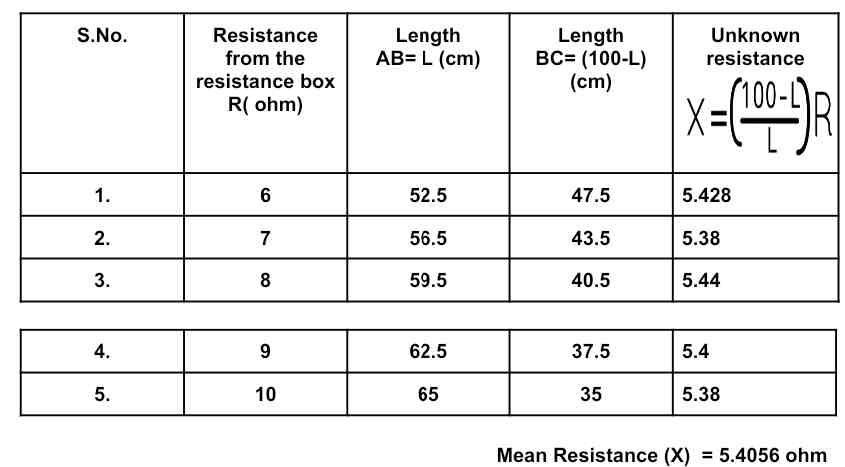Experiment – 2
Objective: To find the resistance of a given wire/standard resistor using a metre bridge.
Required Apparatus:
A meter bridge, a battery eliminator, a galvanometer meter, a resistance box, a jockey, a one-way key, a resistance wire, and connecting wires.
Formula Used:

Where,
R is known resistance placed in the left gap of the metre bridge.
X is the unknown resistance placed in the right gap of the metre bridge.
L (cm) is the length of the metre bridge wire from zero end up to the balance point.
Circuit Diagram:

Observation Table:

Calculations:


Result
- The value of unknown resistance X is 5.4056 ohm.
Precautions:
- The balance point should lie between 40 cm and 60 cm.
- All connections should be clean and tight.
- Hold the jockey perpendicular to the wire of the metre bridge.
- Move the jockey gently on the wire and do not keep the jockey and wire in contact for a long time.
Sources of Error:
- The key of the resistance box may not be clean and tight.
- The wire may not be uniformly thick throughout.
- The screw of the instruments may be loose.
Viva Question-Answers
Q.1. What is metre bridge? Explain in brief.
Ans. The metre bridge was originally developed by Charles Wheatstone to measure unknown resistance values and as a means of calibrating measuring instruments, voltmeters, ammeters, etc. by the use of a long resistive slide wire.
Q.2. Explain the structure of metre bridge.
Ans. The metre bridge consists of a one metre long wire of uniform cross sectional area fixed on a wooden block. A scale is attached to the block. Two gaps are formed on it by using thick metal strips in order to make the Wheatstone’s bridge. The terminal B between the gaps is used to connect galvanometer and jockey. The metre bridge operates under Wheatstone’s principle.
Q.3. Why is the metre bridge so called?
Ans. It is so because it uses a one metre long wire.
Q.4.When is a Wheatstone bridge most sensitive?
Ans A bridge is most sensitive when the resistances in the four arms of the bridge are of the same order of magnitude.
Q.5 How do you define resistivity or specific resistance of material?
Ans . It is defined as the resistance of a metre long wire of the material and having an area of cross-section 1 m².
Q.6 Does resistance depend upon length and area of cross-section of the material?
Ans. Yes
Q.7. What happens to the resistivity of a semiconductor, if its temperature is increased?
Ans. The resistivity of a semiconductor decreases with the rise of temperature.
NCERT Lab Manual Questions-Answer
Q.1. If the metre bridge wire is not made of a material of uniform density, how will it affect the observations?
Ans. We know that resistance of a wire depends directly on density. Hence, in case of non-uniform density we will get wrong measurement of resistance.
Q.2. If the same experiment is performed with AC = 50 cm wire instead of 1 m, what changes would be there in the result?
Ans. We know that resistance varies directly with the length of the wire. Hence, if length becomes half then resistance would also become half.
Q.3. Why is the metre bridge not suitable for measuring very high/very low resistances?
Ans. In case of too high resistance there would be feeble current through the wire. This would not be detected by the galvanometer. In case of too low resistance, there would be error in measurement. Hence, metre bridge is not suitable for measuring very high or very low resistances.

“Q.6 Does resistance depend upon length and area of cross-section of the material? Ans. No.”
Resistance(R) of a wire of length(l) and cross-sectional area(A) and resistivity(ρ) is given by –
R=ρL/A
So, yes, Resistance depends upon length and cross-sectional area of the material; but not resistivity which depends only on temperature and material. Kindly look into it.
By the way, thanks for the notes. It helped me a lot in school.
Thanks